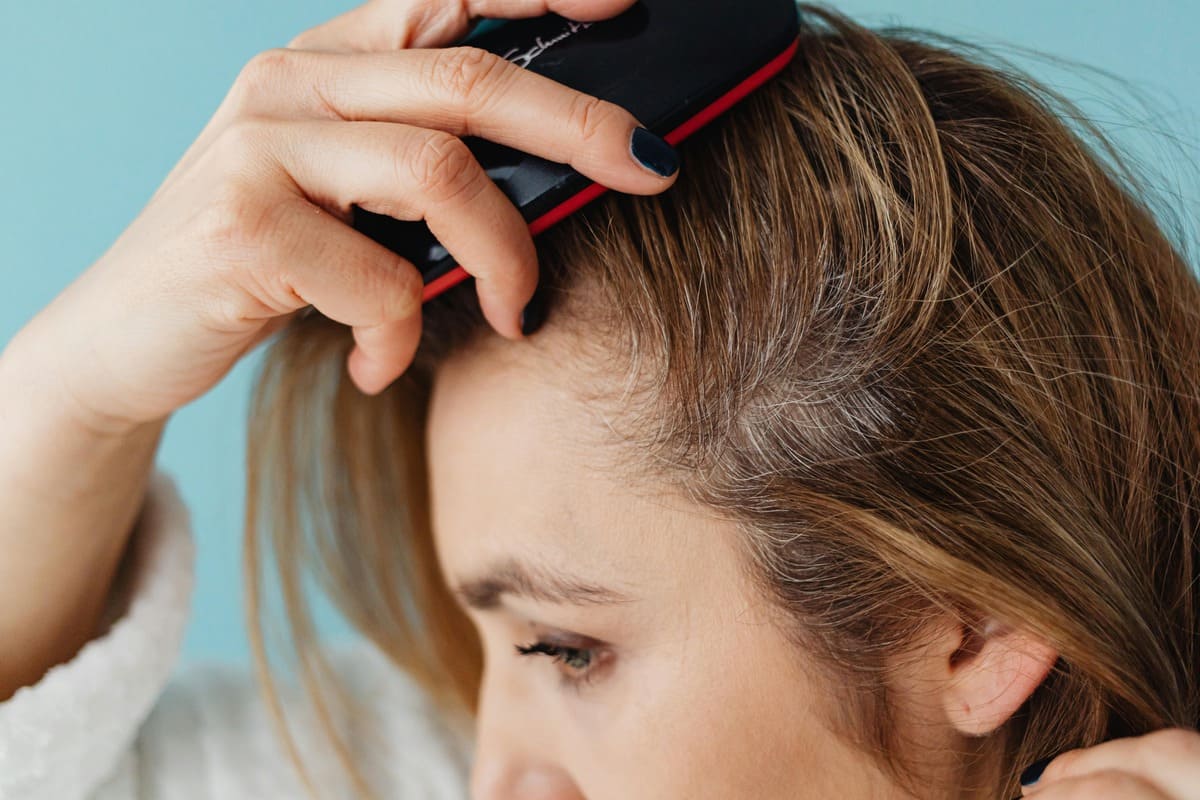Now Reading: Fungal Infection on the Scalp: Causes, Symptoms, Treatments, and Real-Life Stories
- 01
Fungal Infection on the Scalp: Causes, Symptoms, Treatments, and Real-Life Stories
Fungal Infection on the Scalp: Causes, Symptoms, Treatments, and Real-Life Stories

Learn about fungal scalp infections (tinea capitis), their causes, symptoms, and treatments. Explore real-life patient stories, antifungal shampoo solutions, home remedies, prevention tips, and FAQs to restore a healthy scalp.
Introduction
Have you been struggling with constant scalp itching, stubborn flakes that don’t respond to dandruff shampoo, or even sudden bald patches? You may be dealing with a fungal scalp infection.
These infections are more common than most people realize. They’re not just about dandruff they can cause discomfort, inflammation, hair loss, and in some cases permanent scalp damage if left untreated.
In this detailed guide, we’ll cover everything you need to know about fungal infections on the scalp from causes and symptoms to treatments, prevention, and even real-life case stories of people who dealt with them.
What is a Fungal Scalp Infection (Tinea Capitis)?
A fungal scalp infection is a condition where fungi mainly dermatophytes grow on the scalp, leading to itching, scaling, flaking, and hair loss. The medical term is tinea capitis, also known as scalp ringworm. Despite the name, it has nothing to do with worms.
Fungi thrive in warm, damp, and sweaty environments. That’s why infections are more common in humid climates, in children, and among people who sweat heavily or wear helmets/caps for long hours.
Real-Life Case Story #1: The School-Age Child with Tinea Capitis
Riya, a 9-year-old schoolgirl, started losing patches of hair near her crown. At first, her parents assumed it was dandruff or lice, but when bald patches became visible, they consulted a dermatologist.
The doctor diagnosed tinea capitis in children, a fungal scalp infection. Riya was prescribed oral antifungal medication along with ketoconazole shampoo for ringworm. Within six weeks, the infection cleared and her hair began to regrow.
👉 Lesson: In kids, bald spots with scaling are often fungal, not dandruff. Early treatment prevents permanent damage.
Causes of Fungal Scalp Infections
There’s rarely just one reason. Common triggers include:
Poor scalp hygiene – Sweat, oil, and dirt build-up create an environment for fungi.
Sharing personal items – Combs, hats, helmets, pillows, and towels can spread spores.
Direct contact with infected people or pets – Cats and dogs often carry fungal spores.
Excessive sweating – Athletes and gym-goers are more prone.
Weakened immunity – Makes it harder for the body to fight fungal infections.
Existing scalp conditions – Dandruff, psoriasis, or eczema increase vulnerability.
Real-Life Case Story #2: The Fitness Trainer
Arjun, a 28-year-old gym trainer, worked out twice daily and often wore tight caps while exercising. Constant sweating and lack of scalp ventilation caused him to develop itchy red patches and flakes.
Anti-dandruff shampoos didn’t help. A dermatologist confirmed it was scalp fungus, not dandruff. Arjun used an antifungal shampoo for scalp fungus along with topical antifungal cream. Within four weeks, his scalp healed.
👉 Lesson: If you sweat a lot, wash your scalp regularly and avoid tight headgear.
Symptoms of Fungal Scalp Infections
Not all scalp infections look the same. Common signs include:
Persistent itchy scalp
Red, scaly, or flaky patches
Dandruff-like flakes that don’t go away with regular shampoo
Hair breakage and small bald patches
Painful sores or pustules (in advanced cases)
Inflamed, tender scalp skin
💡 Tip: If itching, flakes, and hair loss appear together, it’s more likely fungal than simple dandruff.
What Happens If It’s Left Untreated?
Ignoring a fungal scalp infection can cause:
Severe hair loss or permanent bald spots
Secondary bacterial infections from scratching
Permanent scarring on the scalp
Emotional stress due to visible hair patches
Real-Life Case Story #3: The Busy Professional
Meera, a 35-year-old IT professional, had a hectic lifestyle. She oiled her hair heavily but washed it irregularly. Soon, she noticed persistent flakes, itching, and an unpleasant odor.
The dermatologist diagnosed a fungal scalp infection worsened by excess oiling. Meera switched to a medicated antifungal shampoo and stopped heavy oiling. Within a month, her scalp health improved significantly.
👉 Lesson: Over-oiling can worsen scalp fungus. Fungi thrive in moist, oily environments.
Diagnosis: How Doctors Confirm Scalp Fungus
A dermatologist may use:
Visual examination of scalp patches
Wood’s lamp test (UV light to detect fungal presence)
Scalp scraping or hair sample for lab testing
Fungal culture for accurate diagnosis
This helps rule out psoriasis, eczema, or seborrheic dermatitis, which may look similar.
Treatment for Fungal Scalp Infections
The treatment depends on severity.
1. Medicated Shampoos
Ketoconazole shampoo
Selenium sulfide shampoo
Zinc pyrithione shampoo
👉 Used 2–3 times weekly to reduce fungus.
2. Oral Antifungal Medicines
Griseofulvin (6–8 weeks course)
Terbinafine (often shorter course)
👉 Essential for moderate to severe infections.
3. Topical Antifungal Creams/Lotions
Used directly on patches, usually with shampoos.
4. Home Remedies (Supportive Only)
Tea tree oil (diluted with carrier oil)
Neem rinse (boiled neem leaves in water)
Aloe vera gel (soothes irritation)
Apple cider vinegar rinse (restores scalp pH)
⚠️ Note: These may relieve symptoms but cannot replace medical treatment.
Healing Timeline
Mild infections: 2–4 weeks with shampoo + cream
Severe infections: 6–8 weeks with oral antifungal medicine
Children: May take longer due to deeper infection
Real-Life Case Story #4: The Pet Owner
Sahil, a 22-year-old student, loved his pet cat. After weeks of scratching and bald patches, he discovered his cat had ringworm, which had spread to him.
Sahil took oral antifungal treatment while his cat received veterinary care. Both recovered.
👉 Lesson: Pets can spread scalp ringworm. Treat both the person and the pet to stop reinfection.
Prevention Tips
Wash hair regularly with a mild or antifungal shampoo.
Dry scalp thoroughly after workouts or sweating.
Avoid sharing combs, towels, hats, or helmets.
Disinfect brushes and hair accessories regularly.
Keep pets clean and check for skin infections.
Boost immunity with a balanced diet.
10 Frequently Asked Questions (FAQs)
Q1. Can a fungal scalp infection cause permanent hair loss?
👉 Only if untreated. With proper care, hair usually grows back.
Q2. Is scalp ringworm contagious?
👉 Yes. It spreads through direct contact, shared items, or infected pets.
Q3. Can antifungal shampoo alone cure it?
👉 Mild infections may clear with shampoo, but severe cases need oral antifungal treatment.
Q4. How long before I see results from antifungal shampoo?
👉 Typically within 2–4 weeks of regular use.
Q5. Can children get tinea capitis?
👉 Yes. It’s most common in children between 3–14 years.
Q6. Do home remedies cure scalp fungus?
👉 No. They may soothe symptoms but don’t eliminate infection completely.
Q7. Can I oil my hair during a fungal infection?
👉 Avoid heavy oils, as they worsen fungal growth.
Q8. Can pets spread scalp ringworm?
👉 Yes. Cats and dogs are common carriers.
Q9. What is the best antifungal shampoo for scalp fungus?
👉 Options include ketoconazole, selenium sulfide, and zinc pyrithione shampoos.
Q10. Can fungal scalp infections return after treatment?
👉 Yes, if scalp hygiene is neglected. Prevention is key.
Conclusion
Fungal scalp infections are often mistaken for dandruff but are a very different problem. From children with tinea capitis to gym trainers with sweaty scalps and pet owners exposed to ringworm, anyone can be affected.
The good news is that with the right antifungal shampoos, oral medications, supportive home remedies, and hygiene habits, these infections are fully treatable.
👉 If you have persistent itching, flakes, or bald spots—don’t ignore it. See a dermatologist and start treatment early. Remember, healthy hair begins with a healthy scalp.















